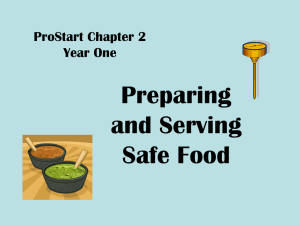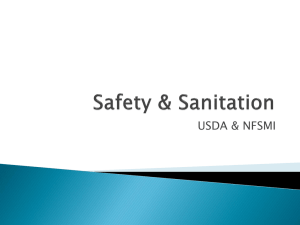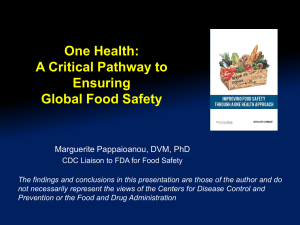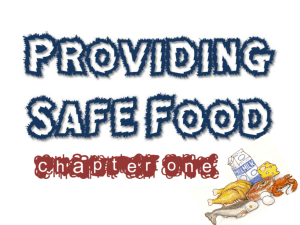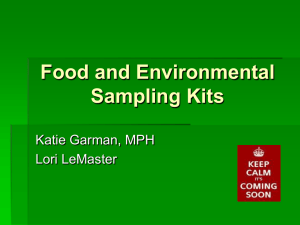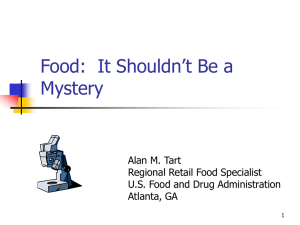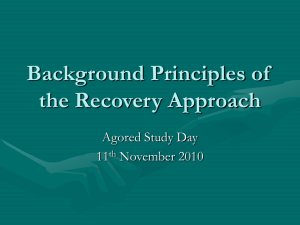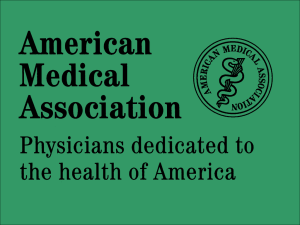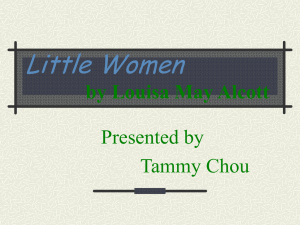SVN 3E - 3.5 - Personal Hygiene and Household Cleanliness p
advertisement
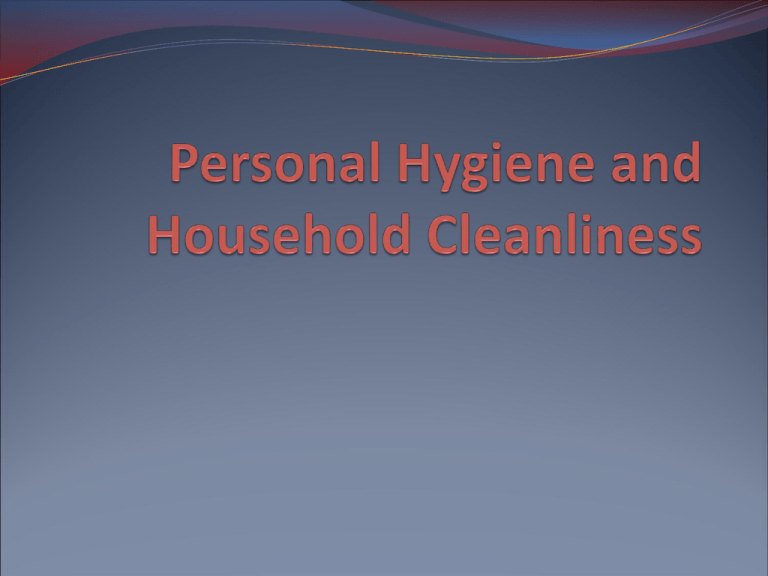
Personal Hygiene and Household Cleanliness What are some good personal hygiene practices that you use....or should use? Washing your hands and food, and keeping your house clean Washing Your Hands to Reduce the Spread of Disease Washing hands = single most effective way to prevent infectious disease Hands spread 80% of infectious disease ie) common cold, flu When should you wash your hands? a. Before and after preparing meals and eating b. After using the washroom c. After handling pets d. After blowing your nose or coughing and sneezing • What is considered proper practice for sneezing now? Washing Hands Need three things: a. Water b. Soap – soap does not kill germs c. Rubbing of Hands – kills germs with soap and water because it helps to break down the dirt and grease that germs cling to Washing Hands Public Health Agency of Canada Antibacterial soaps and household cleaners are not better at preventing the spread of common illnesses than regular soaps and cleaners Antibiotic resistance: overuse of antibacterial soaps and cleaners resulting in antibiotic drugs and disinfectants no longer able to kill micro-organisms that cause disease can use alcohol-based cleaners Kill both good and bad bacteria Washing Hands Washing Hands 1. Wet hands: Remove all rings or other jewellery, and wet your hands with warm running water. 2. Soap: Put a small amount of liquid soap in the palm of one hand. If using bar soap, set it on a rack so it does not sit in water. Bar soaps that stay moist attract germs. 3. Lather: Scrub your hands together. Make sure to scrub between your fingers, under your fingernails, and the backs of your hands. Do this for about 20 seconds (this is about the same time it takes to sing a short song like “Happy Birthday” twice). Washing Hands 4.Rinse: Rinse your hands with warm running water for at least 10 seconds. Try not to handle the faucets in public washrooms once your hands are clean. Use a paper towel to turn off the water. 5.Dry: If you are in a public washroom, dry your hands with a single-use paper towel or air dryer. Protect them from touching dirty surfaces as you leave the washroom. If you are at home using a hand towel, be sure to change it daily. At home during cold and flu season, each member of your family could have their own hand towel. Washing Hand Good and simple hygiene practices to stop spread of germs at home, work, school: Disinfect your kitchen sink and counters daily using bleach, ammonia, alcohol, or vinegar-based cleaners. (Cleaning with soap removes dirt. Disinfecting kills germs.) Regularly disinfect your bathroom, including all doorknobs and faucets. Regularly disinfect your desk and computer keyboard, and avoid eating at your desk. Washing Hands Keep your hands away from your eyes, nose, and mouth. Cough or sneeze into your elbow instead of your hands. Do not share pens, cups, glasses, dishes, or cutlery at school or work. Do not pick up magazines and newspapers in doctors’ waiting rooms, staff kitchens, or on public transit. Stay at home if you are sick to avoid spreading germs to other people. Foodborne Illness and Safe Food Handling 11-13 million Canadians each year suffer from foodborne illnesses Foodborne Illness: person gets sick from eating food that has been contaminated with an unwanted microorganism or pathogen = Food Poisoning Symptoms: stomach cramps, nausea, vomiting, diarrhea, fever....as well as death Example: Botulism Poisoning – poorly preserved food; result in respiratory failure and death Foodborne Illness and Safe Food Handling Practices Hard to control because most food is produced and processed in large amounts by big corporations and/or is imported Once in food processing plant, can cross-contaminate other food All of these factors lead to a greater chance of foodborne bacteria being spread to a large number of people Foodborne Illness and Safe Food Handling Practices New types of foodborne bacteria are being identified Example: Listeria Monocyogenes – causes Listeriosis Contaminated meat products – Maple Leaf Foods recall Foodborne Illness and Safe Handling Practices In Canada, federal, provincial, and municipal levels of government are responsible for public health and food safety Canadian Food Inspection Agency (CFIA): Set rules for how food is processed and sold Tests for safety and warns public if discover unsafe food products http://www.inspection.gc.ca/english/toce.shtml Foodborne Illness and Safe Handling Practices Bacteria can survive food processing Food can also become contaminated during preparation, cooking, storage Safe food handling practices = covers how you buy, store, handle and prepare food Bacteria grow between 4-60 degrees Celsius Keeping food cold (below 4 degrees C) slows growth of bacteria Freezing food (below 18 degrees C) stop from growing Foodborne Illness and Safe Handling Practices Freezing bacteria wont kill it, need to cook food to kill it Food Temperature (°C) Beef, veal, and lamb (medium-rare) 63 Beef, veal, and lamb (well done) 77 Pork 71 Poultry (e.g., chicken, turkey, duck), pieces 74 Poultry, whole 85 Egg dishes 74 Other foods (e.g., hot dogs, stuffing, 74 leftovers) Foodborne Illness and Safe Handling Practices Foodborne Illness and Safe Handling Practices Clean: Always wash your hands, utensils, and cooking surfaces before handling food, while you prepare it, and after you are finished. Disinfect kitchen surfaces and utensils. Wash fruits and vegetables with fresh cool running water before preparing and eating them. Use a brush to scrub produce with firm or rough surfaces (e.g., potatoes, carrots). Foodborne Illness and Safe Handling Practices Separate: Keep meats and their juices separated from other food in the refrigerator and during preparation. Keep separate cutting boards and utensils for raw meats and vegetables/fruits. Always keep food covered in the refrigerator. Foodborne Illness and Safe Handling Practices Chill: After grocery shopping, refrigerate fruits and vegetables quickly. Keep your refrigerator at the proper temperature (≤ 4 °C). Keep your freezer at the proper temperature (≤ -18 °C). Refrigerate/freeze leftovers and prepared food within two hours. Foodborne Illness and Safe Handling Practices Cook: Prepare food quickly. Cook food to a safe internal temperature and serve it immediately. Do not let food sit out at temperatures where bacteria can grow (between 4 and 60 °C). Indoor Air Quality Indoor air pollutants can be biological and chemical Biological: mould, bacteria, dust mites Chemical: volatile organic compounds (VOCs) in household products; gases and particles from fuelburning appliances (furnace, gas stoves, tobacco smoke, building materials, outdoor air) Indoor Air Quality Health Canada 3 main ways that should be used together to improve indoor air quality 1. Source control – preventing pollutants from getting into the air a. Avoid smoking indoors. b. Keep your home clean by dusting and vacuuming regularly. c. Keep your home dry. Control the degree of moisture in the air, or the humidity, by using a humidifier. Fix anything in the house that causes dampness and allows mould to grow. Indoor Air Quality d. Make sure all of the fuel-burning appliances in the house are working properly. e. Avoid idling cars and lawnmowers in attached garages. f. Reduce off-gassing of household materials and products by using/installing paints, cleaning products, insulation, carpets, and other household products containing fewer VOCs. Indoor Air Quality 2. Increase ventilation – moving outdoor air indoors; decreases stale air and reduce indoor air pollutants a. opening windows and doors; b. turning on kitchen and bathroom fans; c. installing mechanical heating, ventilation, and air conditioning systems (HVACs) that can bring in outdoor air, vent stale air, circulate air, and control temperature and humidity. Indoor Air Quality 3. Air Cleaning – remove impurities from air; some remove particles, not as good at removing gases i. Ion generators – portable units that use static charges to trap particles ii. Electronic air cleaners – use electrical field to trap particles


